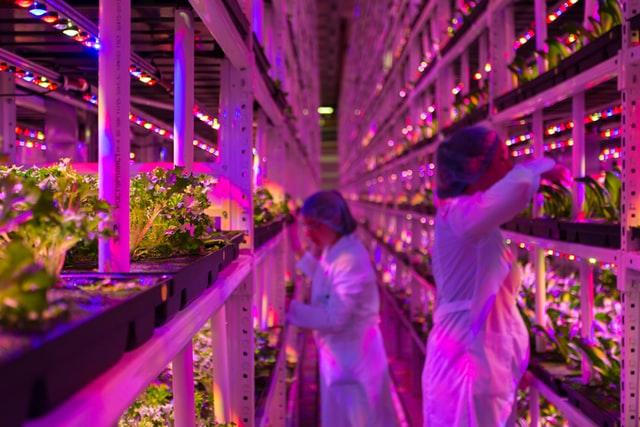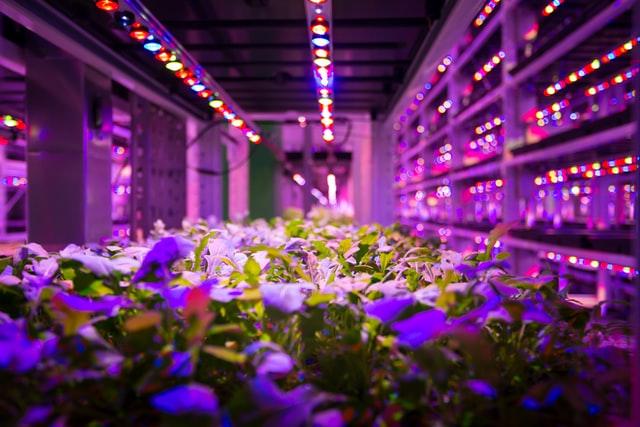Cities are the main source of carbon emissions. It is also the most heavily affected by climate change and water shortages. On top of that, a growing population threatens to further worsen these situations. And with more people comes more mouth to feed. Perhaps we should think laterally and bring to the city some of the things that make the countryside so much more environmentally friendly.
One prospect is that cities may turn to produce the food needed to feed their growing population. This can also reduce the heat islands effects. And such a development would reduce carbon emissions by reducing food imports and an increase in urban vegetation would help absorb some of the emissions from cars and energy production facilities. Hence, the concept of “vertical farming”.

Contents
Vertical farming
Growing food vertically is a great way to save space and get healthier food. Many people associate this technique with city farming but it can be used anywhere indoors. Whether you want to grow vegetables or eat vegetables, vertical farming can help. With the increase in urban populations, climate change and inflation, more people are looking to grow their own food.
Vertical farming grows plants in trays or modular structures. The crop is grown without the use of synthetic fertilizers, herbicides or chemicals. In addition, it can be integrated into skyscrapers, warehouses or shipping containers. This way, plants can grow in a smaller space than in horizontal farming. This means that the farm can be built anywhere and without a huge footprint.
With the increased urban population, vertical urban farms provide a large number of advantages for cities. This method of agriculture can reduce the need for expensive land and reduce water wastage. It is also possible to grow crops year-round and can be profitable as well. In addition, urban farming may be a part of a solution for the planet’s growing population.

The world’s population is expected to reach 9 billion people by 2050, with two-thirds of the world’s population living in urban areas. With this massive increase in urban populations, demand for food increases. Vertical farming could help to meet these demands while reducing carbon emissions.
An upright farm reduces its carbon footprint by up to 80%. It can even be made to utilize organic waste from cities, thus reducing air pollution and greenhouse gas emissions. And the increased greenery can reduce air pollution and greenhouse gases. In addition, vertical cultivation may also solve food shortage problems. Growing plants vertically is an effective way to reduce food waste.
Why do we need vertical farms?
Vertical farming provides many interesting solutions for food production. There are many different implementations but all of them have the same benefit of reducing the amount of land needed for food production and carbon footprint. This allows efficient use of brownfield, urban and marginal spaces.
Indoor farms have many benefits. One of them is the ability to decrease water consumption. The world is facing a water crisis and traditional farming consumes a lot of water. Moreover, most of the water consumed in traditional farming goes to waste. Hence, Vertical farming can be an effective solution as it requires 70-95% less water than conventional farms.
Additionally, this type of agriculture practice can be implemented on a large scale, which means that water savings can be redirected to regions that are facing water shortages. It can also minimize evaporation and closely monitor humidity levels. They also recycle the water they use for crops and plants, which is important since freshwater is not an infinite resource.
And since vertical farms do not require large plots, they can reduce CO2 emissions. Carbon neutrality is one of the most important aspects of indoor farms. Trees store CO2 from their planting to old age. Vertical farming to help combat climate change. By combining sustainable farming practices with indoor farming, large-scale farming methods will be significantly more sustainable.

A recent report showed that vertical cultivation can reduce greenhouse gas emissions as well as methane emissions. The agricultural sector accounts for about 3 billion tonnes of GHGs every year and it uses about 28% of the world’s arable land. By using controlled environments, on-site farming prevents waste caused by weather conditions, pests, rot and other issues.
Food waste is one of the largest causes of GHGs and vertical farming can help to curb this. This method of farming uses only a fifth of the land needed for traditional farming. It also requires no pesticides or fertilizers as produces are grown in a controlled environment. Moreover, since food is grown in controlled environments, they do not use harmful chemicals that cause ecosystems to suffer.
In terms of food safety, because the environment is controlled, pests and fungal diseases won’t have the opportunity to enter the area. Unlike conventional farming, these crops are grown in a controlled environment which decreases post-harvest spoilage. It can also be custom-made to grow a specific crop.
Indoor farms can produce traditionally seasonal crops all year round. Additionally, this agricultural practice is weather-proof, meaning that extreme temperatures and flooding will not affect crops in these. This means no seasonal crop shortages. And it can bring food production into the heart of cities and get fresh produce every day.
As a result, these methods reduce the amount of food that needs to be transported from rural areas to urban markets. By using indoor farms, food producers are also reducing transportation-related carbon emissions. On average, lettuce travels 2,055 miles before it reaches the consumer. The resulting transport emissions from vertical farms are much lower than those from conventional farming methods. And since many vertical farms are close to urban areas, they can be delivered fresh and healthy.
The benefits of vertical farming go far beyond the food they produce. For example, they help create self-sustaining communities, providing all plant requirements year-round. Further, modern indoor farms can use data mapping algorithms to monitor crop growth and maintain ideal conditions until harvest.
If these upright farms are run using renewable energy, their carbon footprint will be considerably smaller than if they were operating outdoors. A self-sustaining vertical farm would supply enough food for up to 50,000 people, fit into a city block and be up to 18 stories high. Another added benefit is that it can create jobs.
Future of vertical farming
Vertical farming can be a great way to increase farm production while decreasing environmental impacts. Just about anything can be grown in an indoor system, it’s cheaper to focus on high-value crops that will sell well. The advantages of this approach are largely economic, environmentally friendly, and health-conscious.
Vertical farms will not replace traditional farms, they will rather supplement them. Though it’s still a relatively new practice, its benefits can be significant for the economy. It’s not only a viable way to grow more food while decreasing carbon footprint but it also helps to address food security and hunger concerns.

In the future, vertical farms may even play a key role in helping us prepare for food shortages. Besides its environmental benefits, this practice is also a highly effective means of production in cities with limited natural resources. Compared to conventional agriculture, it can be constructed in buildings.
Furthermore, it can be built anywhere where utilities are available, even within major cities. Indoor farming can also help return land to the earth, facilitating recovery from deforestation and helping restore the habitat for threatened species. Further, future colonization of the earth will be made much easier if vertical farming becomes popular in cities around the world.
In addition to being environmentally friendly, indoor agricultural practices reduce the need for fossil fuels for farm equipment and machinery. Ultimately, the benefits of vertical farming will benefit the entire planet, especially those with lower incomes. It has the ability to increase the amount of food produced per square meter.
By stacking crops in a tower structure, vertical farms can maximize crop production while using 95% less water and land. They could help us solve the food desert problem by providing access to healthy food. Averting the need for long shipping and agrochemical production processes.
And because vertical farms are self-contained, the crops can be grown year-round without the need to worry about the weather. The future of vertical farming is bright. The benefits are numerous. The cost savings can make it a great option for anyone who’s looking to save money on land or water.

0 Comments